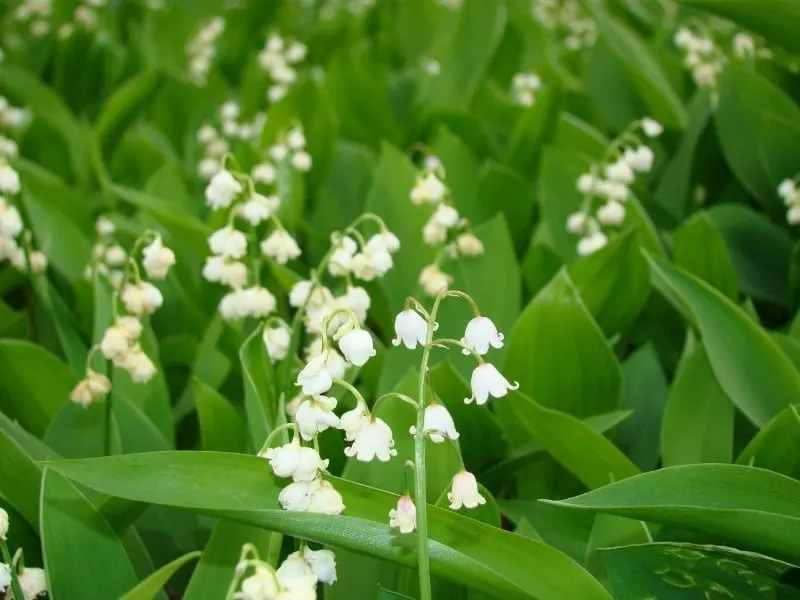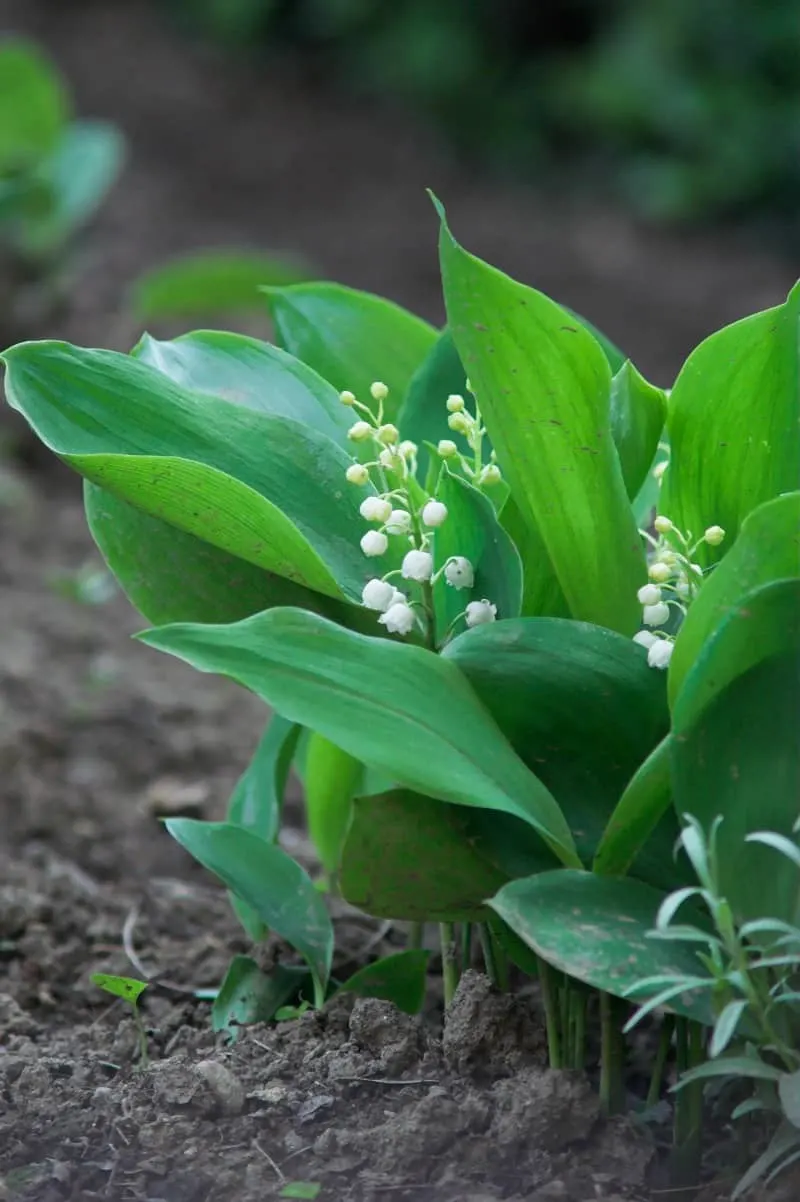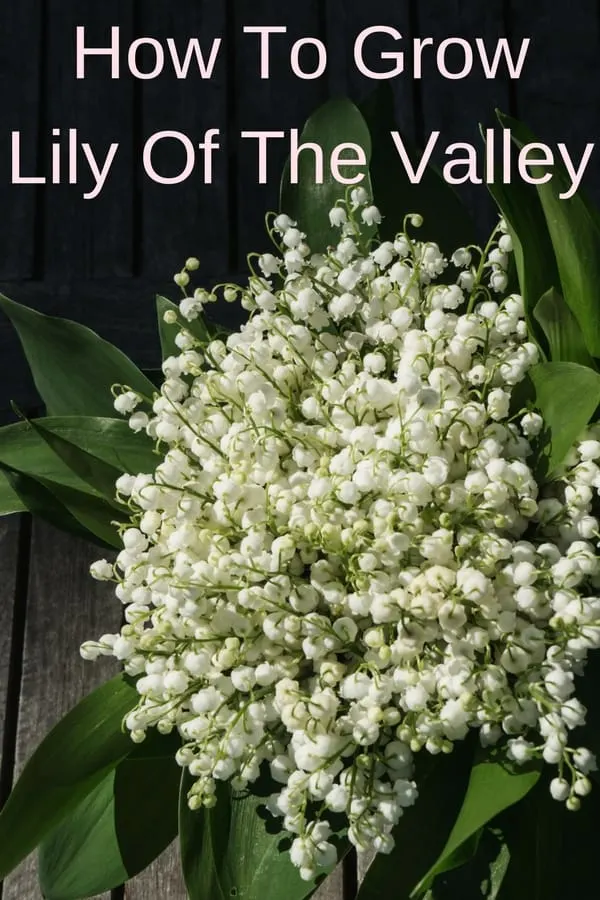Lily-of-the-Valley (Convallaria Majalis) is my favorite flower. It’s dainty and has a wonderful fragrance, but is very poisonous. While flowers will open in the garden in May and June, they may also be coaxed into blooming by the gardener. Let’s see how to grow lily of the valley.

Lily of the valley – a flower with a legend
Native to Europe, but also naturalized in the eastern United States, Lily-of-the-Valley is one of the prettiest flowers found in the wild. It grows in open woodland, is easy to grow in the garden, and can be forced into bloom artificially any time of the year.
The botanical name Convallaria meaning “Lily-of-the-Valley”, is biblical in origin: The tears of Mary Magdalen, shed during her embalming of Christ, were said to have flowed to the valley, where they sprang into life as lilies.
How To Grow Lily Of The Valley
Lily of the valley – a fragrant perennial
Lily of the valley is a perennial with strong roots and a white, underground, creeping tuber, partly horizontal and partly upright. This tuber has a short, thick shoot, called pip from which grow leaves and flowers.
The leaves have long stems, surrounded by smaller leaves at the base.
The white, bell-shaped flowers hang on short stalks in 6 to 10-inch clusters. They have a strong, heady scent.
Want to learn more about scented gardens? Here’s a list of fragrant flowers you can try.
Buying tips
Buy tubers that will bloom at the desired time of year. Check that roots are fresh and not dried out.
While you can buy lily of the valley tubers almost any time of year, in the wild, the natural blooming season is from May to June.
These beautiful flowers are very easy to grow: once you plant them in the right conditions, they bloom each year in the garden.
Many people look for lily of the valley bulbs, but they are actually called pips and don’t really look like a bulb.
You can buy lily of the valley seeds, but you’ll need to be careful, as the red berries of the plant are poisonous. Wear gloves while handling them.
You should be aware that growing this plant from seed will mean waiting to see flowers for several years. It’s best to just plant pips.
Planting lily of the valley in the garden
Plant pips in the fall before freezing about 1.5 inches deep in clumps. Lily of the valley likes it best in the shade, with just a bit of sunshine for good measure.
Many years ago we lived in MA and had a forest full of them: I can’t even begin to describe the feeling of walking through that fragrant forest every spring!
Remember to keep your freshly planted flowers watered well.
While lily of the valley flowers are beautiful oy look at and smell amazing, they CAN be invasive in some areas. Make sure you check with your local agriculture department before planting them in your garden
Related: what to plant under a pine tree

How to force lily of the valley
Lily-of-the-Valley can be forced at any time of year by professional nurseries and is often used in bouquets.
Buy plants for forcing in October or take them from the garden after two to three years’ growth. Put the plants in the ground immediately after purchase and don’t allow leaves to dry out.
Use pots with good drains. Trim the root to three to four inches and plant in garden soil mixed with sand. Water well. Bury pots in the garden and cover them with sand or moss.
Move the flowers indoors for forcing in December, or even later, and give them a warm water treatment at about 85°F. Stand pots (at 77°F) in a dark, humid spot for the first 12 days. When stems have reached about four inches, the temperature can be lowered gradually to about 66°F and the plants are slowly introduced to the light. Forcing flowers takes about four to five weeks.
How to grow lily of the valley indoors
These adorable bell-shaped flowers would make great gifts for Mother’s day if you planted them in a pot. Here’s how to do it!
Pink lily of the valley
Harden to find, and a bit more expensive, pink lily of the valley flowers are just as pretty and delicate as their white sisters.
They look great indoors potted up or used as a fragrant ground cover.
I’ve never seen one personally, but I hear the blue lily of the valley is gorgeous.
Very poisonous
The flowers open in May and June, followed by eye-catching red berries. These, like the rest of the plant, are very poisonous.
Despite that fact, the plant has been used as a medicinal herb for centuries. The plant’s soluble glycosides can be used for various heart ailments, but are not without danger. Don’t try to ingest any part of this plant. In fact, wear gloves when you handle its berries.
Keep pets away from your lily of the valley flower bed. Click here to find out what other plants are harmful to pets.
Lily of the valley problems
If you see spotted leaves your plants probably have a fungus infection (gray or brown spots). Use a fungicide.
The lily beetle’s larvae can cause holes at leaf edges or centers. These larvae are brownish-green, while the adult beetle is a bright red. Pick the insects off or spray with a systemic insecticide.
Do not let roots dry: gray mold can attack dried shoots.
I hope that this little guide showed you how to grow lily of the valley in your own backyard.

Adriana Copaceanu is a passionate nature lover living in the country on her dream property where she grows vegetables, lavender, and wildflowers that she shares with the wildlife they attract. When she's not in the garden, she loves spending time with her chickens and planning her next nature project. Check out her books below:
How to Grow Lavender for Fun and Profit: Lessons Learned from Planting Three Hundred Lavender Plants


Donna
Sunday 30th of July 2023
Reading the comments helped me to decide how to plant Lilly of the Valley. I potted them and will separate in the fall. I have a few plants such as mint, hostas and lambs ear that I have to keep track of or they run amuck in the garden.
9 Pristine White Shade Perennials For Low Light Gardens
Friday 3rd of March 2023
[…] Learn more about how to grow lily of the valley. […]
18 Plants With Adorable Tiny Flowers
Sunday 3rd of July 2022
[…] lily of the valley plant or the Convallaria majalis has tiny spring flowers that are white and bell-shaped. The white […]
Marnie
Monday 24th of January 2022
You forgot to mention how invasive this plant can be! I love lilly of the valley.. but it took over the whole flower bed.. and lawn. I moved it to my back fence and let it spread there.
Holly Graham
Sunday 12th of June 2022
@Inda in NZ,
Lily of the Valley & Violets are quite easily my favorite flowers. The Lily’s scent is sweet, yet “green”, and the violets can be a complex mix of lovely shades of purple, sometimes brushed with yellow in the centers. Both have outgrown designated spaces in my yard. I don’t try to stop them, and I am lucky to have such a strong grouping which has pleased me since I bought my house in Sept. of 1999. I live in suburban Chicago, IL. They love it here!
Inda in NZ
Friday 29th of April 2022
@Marnie, I can’t think of anything I’d like better than for my Lily if the valley to ‘invade’ everywhere.. The smell would be wonderful and their appearance too. Hopefully their ground cover habit would deter weeds..
Adriana
Tuesday 25th of January 2022
@Marnie, I added a blurb to the post about it. I personally never experienced its invasive nature (and I lived in 3 different states), but I know they can be invasive in some parts of the world.
11 Miniature Fairy Garden Ideas For A Magical Yard
Thursday 30th of December 2021
[…] lily of the valley […]